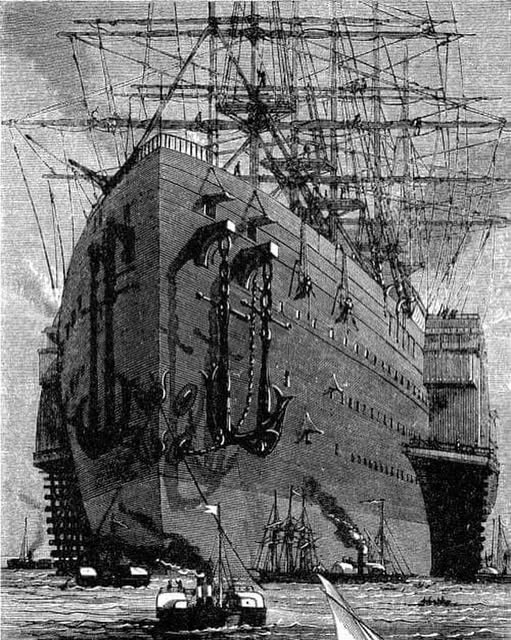In 1858, Britain unveiled a ship so colossal and revolutionary that it left even the most seasoned engineers in awe: the SS Great Eastern. Designed by the legendary Isambard Kingdom Brunel, this massive vessel was not only the largest ship ever built at the time, but it was also an engineering marvel that captured the imagination of the Victorian era. Stretching 211 meters long and displacing nearly 19,000 tons, the Great Eastern was an extraordinary feat of design and ambition.

A Visionary Ship Ahead of Its Time
The Great Eastern was unlike any ship the world had seen before. It was equipped with six masts and sails, enormous paddle wheels, a screw propeller, and five coal-fired steam engines. It could carry up to 4,000 passengers and had enough fuel storage to sail from England to Australia without needing to refuel. For its time, this was nothing short of a futuristic vessel, capable of doing what other ships could not even dream of.
Designed to push the boundaries of sea travel, the Great Eastern promised to revolutionize the maritime industry. At a time when most ships struggled to cross the Atlantic, this steamship was envisioned as a luxury liner that could bridge continents with ease. It was a bold attempt to make long-distance travel more efficient, more comfortable, and more reliable.
Early Struggles and Its Fall as a Luxury Liner
Despite its ambitious design and cutting-edge technology, the Great Eastern faced numerous challenges from the very start. The ship’s launch was delayed by a series of disasters, including boiler explosions, technical failures, and financial setbacks. These issues were compounded by the ship’s enormous size, which led to high operating costs and maintenance challenges.
The dream of turning the Great Eastern into a luxury liner quickly unraveled. Its massive dimensions and complex engineering made it difficult to operate, and investors soon realized that it was far too expensive to run as a passenger ship. As a result, the Great Eastern was deemed a failure in its intended role. The grandeur of its design was overshadowed by the unprofitability of regular passenger service, and the ship was quickly labeled as a financial disaster.

The Ship’s True Purpose: Connecting Continents
However, the story of the Great Eastern didn’t end in failure. In the 1860s, the ship found its true calling: laying underwater telegraph cables. Its sheer size and stability made it the perfect vessel for this task, as it was capable of carrying and deploying long lengths of cable across vast stretches of the ocean.
The Great Eastern played a pivotal role in connecting Europe and North America by laying the first transatlantic telegraph cable. This achievement dramatically changed global communication, allowing messages that once took weeks to travel across the ocean to now be sent in mere minutes. Though the ship had failed as a luxury liner, it became the backbone of a communication revolution that would forever change the way the world connected.
The Lasting Legacy of the SS Great Eastern
The Great Eastern was dismantled in 1889, but its legacy lived on. Its design and engineering principles continued to influence maritime technology for decades. The ship’s bold design inspired writers and engineers alike. Notably, Jules Verne featured the Great Eastern in his novel A Floating City, using the ship as a symbol of technological progress.
For engineers and naval architects, the ship became an important case study in innovative shipbuilding. Brunel’s daring vision, though initially ahead of its time, would eventually lay the groundwork for the ships and technological advancements of the future. The Great Eastern was ultimately remembered not as a failure, but as the ship that was too advanced for its era.
Conclusion: A Ship That Changed the World
The SS Great Eastern may have failed as a passenger ship, but its true legacy lies in its contributions to global communication. It played a critical role in shaping the modern, connected world by facilitating the laying of transatlantic telegraph cables. While its size and complexity made it impractical for its original purpose, the ship’s design and eventual success in other fields cemented its place in history as an innovative and visionary marvel.
Today, the Great Eastern is remembered as the ship that was “too big for its time.” However, its influence on both the maritime industry and the world of global communications continues to inspire engineers, historians, and technology enthusiasts to this day.
For more incredible stories, check out Man Loses 360 Pounds Naturally: Internet Rallies to Support His Next Step or Tammy Hembrow’s Bikini Photos Are Stirring Controversy: Here’s Why Everyone’s Talking.



